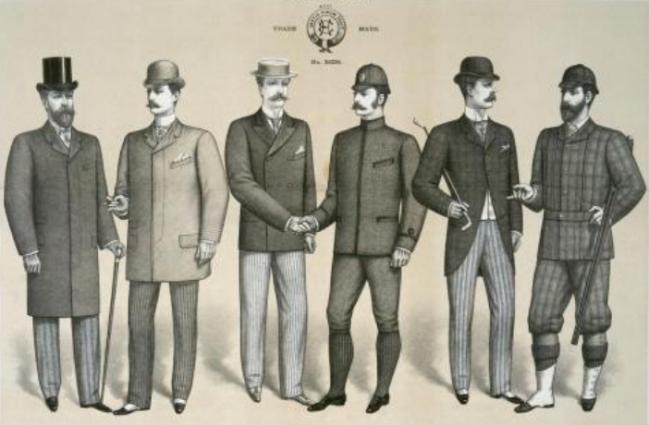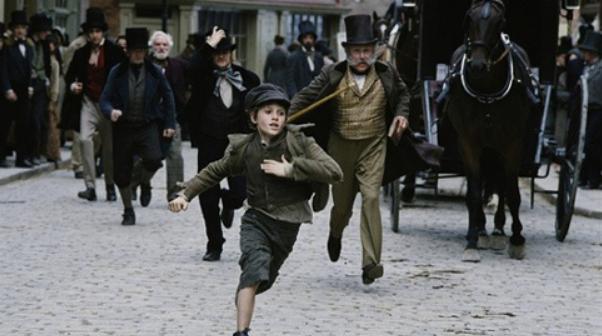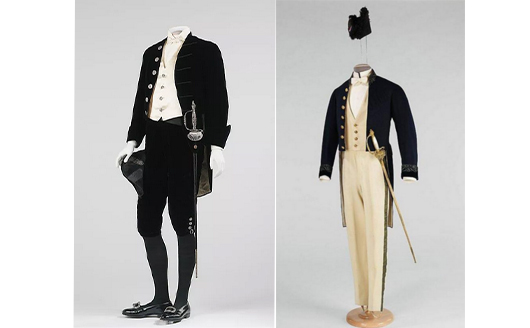Men's Gothic Costumes In Victorian
Goth fashion is recognized by its absolute black clothing. The period of Queen Victoria’s sovereignty (1837-1901) which is called the ‘Victorian era’ in the history of the United Kingdom is the origin of Victorian fashion. Black color is traditionally associated with mourning for the dead. Queen Victoria wore the dress which showed traditional touches of mourning attire, from the death of her husband until her death. Her style became famous and people started adopting this dramatic fashion by wearing dark colors and dark makeovers. Men used to wear calf-length frock coats in dark colors mostly black, tight fittings and a vest or waistcoat in the early 1840s.

They used to wear single or double-breasted vests with shawls or notched collars. A cutaway morning coat with light trousers was worn during the daytime and a dark tail coat with trousers was worn in the evening. Linen or cotton fabric was used forGoth shirts. Low collared shirts occasionally turned down were worn with neckties or wide cravats. For formal functions and horse riding, top covering the body from the waist down usually ends just below the knee called breeches were worn and top hats with wide brims in sunny weather. In the 1850s turned collars and four in hand neckties came in fashion. The upper class used to wear top hats and bowler hats were worn by the lower working class. Men started wearing wider ties tied in bow or looped into a loose knot with a stickpin in the 1860s. For business, knee-length frock coats were worn. These frock coats were later displaced by mid-thigh length sack coat worn on less formal occasions. A variety of hats shape were popular including tall ‘stovepipe’ shaped hats. During the 1870s, three-piece suits became so popular along with shirts made of patterned fabric. Ascot ties, neckband with wide pointed wings became popular as well. For tropical climates especially in America, a narrow ribbon tie was worn as an alternative for ascot ties. Both sack and frock coats became shorter in length. During boating, flat straw boaters were worn. Men Gothic pants had fly fronts. Then in the 1880s, formal evening was dark tail coat and trousers with waistcoat dark in color, shirt with a winged collar and a white bow tie. Another form of coat appeared which had the new roll collar became the new tailcoat of this decade which looked like the short form of a lounge wearing jacket, used for day time. Which was known as a ‘dinner jacket’ by the end of the century. A Tuxedo or dinner jacket was worn for more relaxed formal occasions. Woolen breeches and Norfolk jacket which is a single-breasted, loose, belted jacket with box pleats on the front and back were used for outdoor activity such as shooting. In winters, knee-length top coats with fur or velvet collars, calf-length overcoats were worn. Men used to wear shoes with narrow toe and higher heels. Blazer was introduced in the 1890s and was worn for causal activities like sports. The above picture is the perfect illustration of men’s costumes.
Clothing served to control humanity in that era. As the famous novel “Oliver Twist” written by Charles Dickens showed how a poor boy treated because of his physical appearance. The orphan clothes he was forced to wear turned him into a faceless huddled mass. At that time dressing has a great impact on one’s life. Oliver twist was dressed so poorly as an orphan and was treated poorly. Underworld thieves of that time used to wear coats and a handkerchief around their necks, their appearance fits their personality and they get recognized by their appearance. Oliver was an innocent child but he was misunderstood as a thief and was treated accordingly. People used to judge others by the way they look. Different characters in the novel dressed up Oliver in different ways depending on their own interests and changed his personality. His real identity was lost. Scenes describing the manipulation of clothing shows how it plays an important part in the construction of one’s identity. A character named Brownlow purchased him an expensive suit that changed his personality and thus he assumes the identity of a gentleman’s son. He then asked about his views about his life and history which he never been asked before when he was at the workhouse in pauper clothing. It shows that poorly dressed people were not given equal rights. He gained a voice by shedding his pauper clothes. This reveals key differences between the middle and lower classes in the Victorian society.

Gothic clothing fashion was originated in the Victorian era but some of the Goth clothing characteristics have been inherited. Men in the modern era wear tuxedo which was famous in the Victorian era and was used for formal occasions. Formal wear’s protocol has changed a lot over the seven Victorian era decades but the general look and feel has not changed much and still the similar not entirely different from today’s white-tie style. Cut and length of tailcoats changed from time to time. The main difference between the modern one and the Victorian one is fit. Today’s tailcoats have loose fittings as compared to the previous one. Today's men opt for deep cut and square labels vests which was a popular trend in the Victorian era. Formal pants for men haven’t changed much from the past ten decades. The main difference is the height. Victorian pants changed in length from the belly button to rib rage according to the fashion of the year. Today's regular flat tuxedo pants resemble those of the Victorian one with a ribbon striped down the sides. But they need to fit high on the waist so one would buy one size up to dress like an ancient man. Victorian formal shirtshad lace frills which are hard to find today. Collar is the most important element of Victorian formal shirt. Turning up the collar of a normal dress shirt reflects the Victorian fashion. Today's modern fashion has a glimpse of Victorian style and can be worn to reflect ancient times fashion.

References
https://en.wikipedia.org/wiki/Victorian_fashion
https://vintagedancer.com/victorian/victorian-mens-formal-wear-with-modern-clothes/










